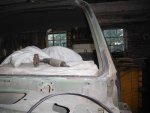Assel
Member
- 197
- 7
- 16
- Location
- Germany Schwarzwald-Baar
So finally I got the possibility to buy a decent MIG welder (its old, but I tried it in the "shop" of the guy I bought it from, its doing really nice welds & everything works as it should) and I paid just a "few" bucks  and got even a full gas bottle with it! ..So nothing can stop me from doin the bodywork my CUCV needs...
and got even a full gas bottle with it! ..So nothing can stop me from doin the bodywork my CUCV needs...


So now my questions are : how hazardous is it really to weld on CARC? some say its not more than usual car paint, some recommend a full ABC protective suit ... When grinding/sanding I use a charcoal filtermask and the clothes get washed twice, but with the welding helmet on I have no respiratory protection... Of course will I avoid the fumes, but if I accidentally inhale it what will it do to me?
Any information about welding on CARC or on a CUCV is appreciated!
Thanks
 and got even a full gas bottle with it! ..So nothing can stop me from doin the bodywork my CUCV needs...
and got even a full gas bottle with it! ..So nothing can stop me from doin the bodywork my CUCV needs...

So now my questions are : how hazardous is it really to weld on CARC? some say its not more than usual car paint, some recommend a full ABC protective suit ... When grinding/sanding I use a charcoal filtermask and the clothes get washed twice, but with the welding helmet on I have no respiratory protection... Of course will I avoid the fumes, but if I accidentally inhale it what will it do to me?
Any information about welding on CARC or on a CUCV is appreciated!
Thanks




